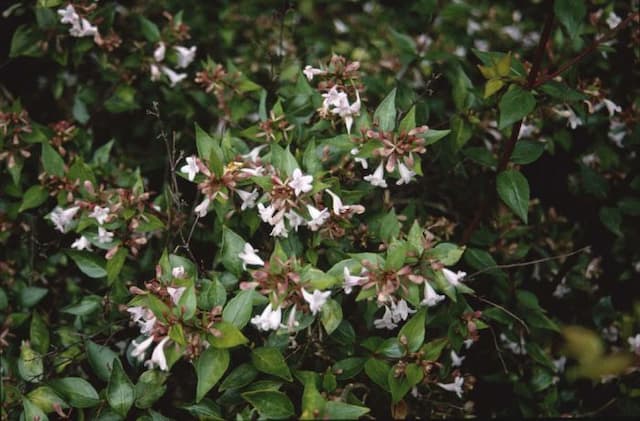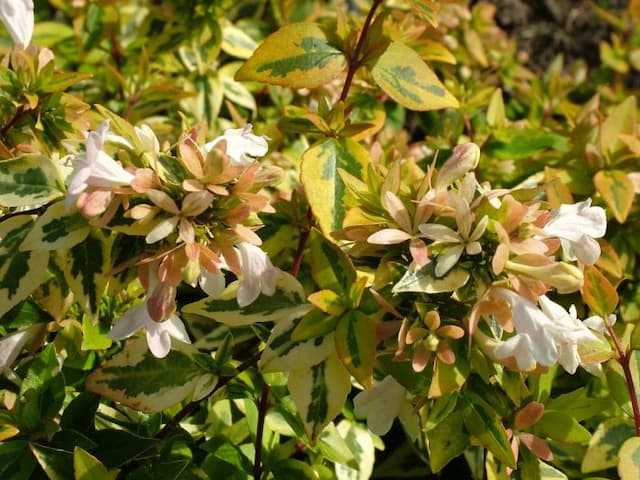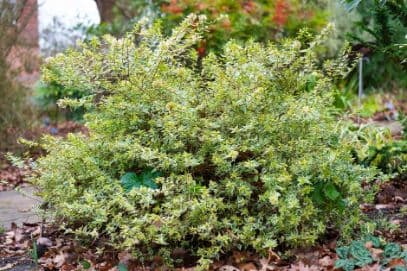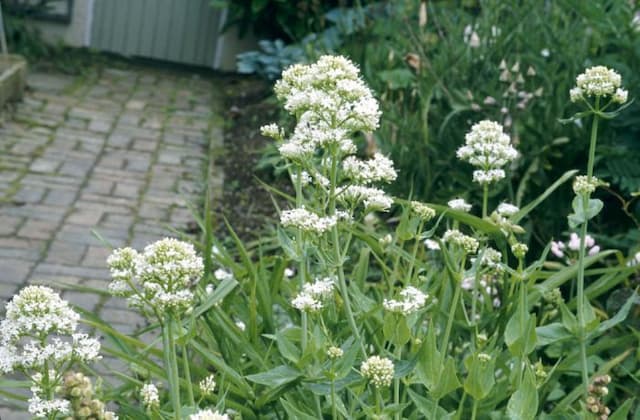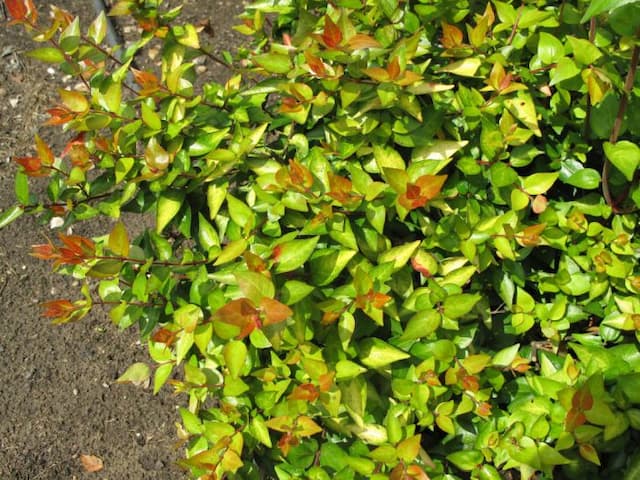Privet Honeysuckle Lonicera ligustrina var. pileata

ABOUT
The plant commonly known as Box Honeysuckle is a dense, evergreen shrub that presents itself with a lush, rounded form. Its foliage is comprised of small, glossy, and oval leaves that are deep green in color, providing a rich texture and an impression of fullness throughout the year. When the growing season arrives, this shrub bursts into a display of delicate, fragrant flowers that typically bear a creamy white hue. These blossoms are both attractive to onlookers and inviting to an array of pollinators, including bees and butterflies. Following the flowering period, the Box Honeysuckle produces berries that may range in color from a translucent red to a deep purple or black, adding yet another layer of visual interest to the plant. The berries not only contribute to the shrub's ornamental appeal but also serve as a food source for birds and wildlife. Consequently, the Box Honeysuckle can be considered both an aesthetically pleasing and ecologically supportive addition to a garden or landscape setting.
About this plant
 Names
NamesFamily
Caprifoliaceae
Synonyms
Privet Honeysuckle, Box Honeysuckle, Boxleaf Honeysuckle
Common names
Lonicera pileata, Lonicera ligustrina var. yunnanensis.
 Toxicity
ToxicityTo humans
Privet is the most common name for Lonicera ligustrina var. pileata. This particular variety of privet is not well-documented for its toxicity to humans; however, privets in general can be toxic when ingested. The berries are considered to be the most poisonous part, although other parts of the plant may also contain toxic compounds. If ingested, toxins from privet can cause symptoms such as abdominal pain, nausea, vomiting, diarrhea, and in severe cases, seizures or cardiac problems. It is highly advised to avoid consuming any part of the plant, and to seek medical attention if ingestion occurs.
To pets
Privet is the most common name for Lonicera ligustrina var. pileata. This plant can be toxic to pets if ingested. The berries are typically the most toxic part, and consumption can lead to gastrointestinal upset including vomiting and diarrhea. In some cases, more severe symptoms such as lethargy, difficulty breathing, and coordination problems may occur. It is crucial to prevent pets from ingesting any part of the plant and to consult a veterinarian promptly if they do.
 Characteristics
CharacteristicsLife cycle
Perennials
Foliage type
Evergreen
Color of leaves
Green
Height
3-4 feet (0.91-1.22 meters)
Spread
3-5 feet (0.91-1.52 meters)
Plant type
Shrub
Hardiness zones
5-9
Native area
China
Benefits
 General Benefits
General Benefits- Wildlife Attraction: Lonicera ligustrina var. pileata, commonly known as Box-leaved Honeysuckle, produces flowers that attract pollinators like bees and butterflies.
- Ornamental Appeal: This plant has attractive foliage and a dense, bushy habit, which is great for adding structure and greenery to gardens and landscapes.
- Privacy Screen: Due to its dense growth, it can be used as a hedge or screen, providing privacy and reducing noise from surroundings.
- Erosion Control: Its root system helps to stabilize soil, making it useful for planting on slopes or in areas prone to erosion.
- Drought Tolerance: Once established, Box-leaved Honeysuckle can tolerate periods of dryness, making it suitable for xeriscaping or areas with water restrictions.
- Shade Tolerance: It can grow in a variety of light conditions, including partial shade, providing options for gardeners with shaded areas.
- Low Maintenance: This plant generally requires minimal care once established, making it a convenient choice for landscapes with less intensive maintenance needs.
 Medical Properties
Medical Properties- Antibacterial: Lonicera ligustrina var. pileata has been traditionally used for its potential antibacterial properties.
- Anti-inflammatory: The plant may contain compounds that help reduce inflammation.
- Antioxidant: It could possess antioxidants which are beneficial for preventing oxidative stress.
 Air-purifying Qualities
Air-purifying QualitiesThis plant is not specifically known for air purifying qualities.
 Other Uses
Other Uses- Lonicera ligustrina var. pileata, commonly known as box honeysuckle, can be used in bonsai culture, where its woody stems and foliage can be artistically shaped and maintained in miniature form.
- The dense foliage of the box honeysuckle can provide a natural sound barrier when planted along roads or in urban environments to reduce noise pollution.
- Box honeysuckle hedges can act as windbreaks, protecting smaller plants from strong winds and helping to prevent soil erosion in exposed areas.
- The wood of the box honeysuckle is of suitable density and can be used in craftsmanship for making small wooden objects or ornamental carvings.
- The planting of box honeysuckle can be used for slope stabilization on banks or hillsides, as their root system helps to hold the soil together and prevent landslides.
- Box honeysuckle can be planted as a privacy screen due to its dense growth habit, creating natural and attractive seclusion for outdoor living spaces.
- The species can be utilized in topiary art, trimmed into various shapes and forms due to its dense branching and foliage, adding an aesthetic dimension to gardens and parks.
- Box honeysuckle can be included in butterfly gardens; although not primarily known for this, its flowers can attract certain species of butterflies and beneficial insects.
- When dried, the branches of the box honeysuckle could be used in rustic crafting projects, such as making wreaths or other decorative items for homes.
- The shrub's dense branching structure provides excellent habitat and nesting opportunities for small birds and wildlife within landscaped garden settings.
Interesting Facts
 Feng Shui
Feng ShuiThe plant Box Honeysuckle is not used in Feng Shui practice.
 Zodiac Sign Compitability
Zodiac Sign CompitabilityThe plant Box Honeysuckle is not used in astrology practice.
 Plant Symbolism
Plant Symbolism- Devotion - Lonicera ligustrina var. pileata, commonly known as box-leaved honeysuckle, often symbolizes devotion due to the way it grows, representative of a commitment to grow and entwine with structures or other plants.
- Bonds of Love - As with many species of honeysuckle, box-leaved honeysuckle can be interpreted as a symbol for the bonds of love, referencing the plant's natural tendency to twine around objects, evoking ideas of a loving embrace.
- Generosity - The abundance of its flowers can be seen to represent generosity, as the plant freely shares its blossoms and the associated sweet nectar with pollinators.
 Water
WaterThe Privet Honeysuckle (Lonicera ligustrina var. pileata) prefers consistent moisture, but it is also drought-tolerant once established. Water the plant deeply about once a week, providing approximately 1-1.5 gallons of water. During the hot summer months or in very dry weather, increase watering frequency to twice a week, ensuring the soil doesn't dry out completely. For potted specimens, water until you see excess water draining from the bottom, indicating the soil is thoroughly moistened. It is critical to avoid overwatering to prevent root rot, so always check the soil moisture level before watering again.
 Light
LightPrivet Honeysuckle thrives in full sun to partial shade. The ideal location is where the plant can receive at least 4-6 hours of direct sunlight daily, with some dappled shade in the afternoon to protect it from the intense heat. If placed in too much shade, the plant may become leggy and produce fewer flowers.
 Temperature
TemperaturePrivet Honeysuckle is hardy and adapts to a wide range of temperatures. It can tolerate a minimum temperature of around -10 to -20 degrees Fahrenheit. However, the ideal growing conditions are between 60 and 75 degrees Fahrenheit. It can sustain higher temperatures but requires adequate watering during extreme heat to prevent stress.
 Pruning
PruningPrivet Honeysuckle benefits from annual pruning to maintain its shape, encourage bushier growth, and remove any dead or diseased branches. The best time for pruning is late winter or early spring before new growth begins. Prune up to one-third of the old growth to revitalize the plant and encourage fresh, new stems and leaves. Regular pruning also helps to stimulate flowering and keeps the plant within its desired size.
 Cleaning
CleaningAs needed
 Soil
SoilPrivet honeysuckle (Lonicera ligustrina var. pileata) thrives in well-draining, loamy soil enriched with organic matter. The ideal soil pH for this plant is slightly acidic to neutral, ranging from 6.0 to 7.0. A mix of two parts garden soil, one part well-rotted compost or peat, and one part sand or perlite can create optimal growing conditions.
 Repotting
RepottingPrivet honeysuckle typically requires repotting every 2 to 3 years to ensure the root system has ample space to grow. It's best to repot in the early spring before the onset of the growing season.
 Humidity & Misting
Humidity & MistingPrivet honeysuckle prefers moderate to high humidity levels but is quite adaptable. Aim for a humidity level between 40% to 60% for optimal growth.
 Suitable locations
Suitable locationsIndoor
Place in bright, indirect light and water when the topsoil feels dry.
Outdoor
Plant in partial shade to full sun in well-drained soil.
Hardiness zone
5-9 USDA
 Life cycle
Life cycleLonicera ligustrina var. pileata, commonly known as Box-leaved Honeysuckle, begins its life cycle when a seed germinates, typically in spring, under suitable temperature and moisture conditions. The seedling then develops into a juvenile plant, producing a dense cluster of foliage as it becomes established. This evergreen shrub enters a period of vegetative growth, where it expands its root system and develops strong stems and leaves to harness sunlight and nutrients. In early to mid-summer, Box-leaved Honeysuckle blossoms, producing creamy white, tubular flowers that attract pollinators; these flowers are followed by small purplish-black berries that provide food for wildlife. After flowering, the plant continues to grow and may spread through layering, where branches in contact with soil form roots and develop new plants. The Box-leaved Honeysuckle matures over several years and can live for an extended period, with a cycle of flowering and seed production occurring annually.
 Propogation
PropogationPropogation time
Spring-Summer
The most popular method of propagating the Privet Honeysuckle (Lonicera ligustrina var. pileata) is by semi-hardwood cuttings. This is typically done in the late summer or early fall. Cut a 4 to 6-inch (10 to 15 cm) section of stem from the current year's growth, ensuring that there are at least two or three sets of leaves. The bottom set of leaves should be removed, and the cut end dipped in rooting hormone powder to stimulate root growth. Then, the cutting should be placed in a well-draining rooting medium such as a mix of peat and perlite or sand. The cutting should be kept moist and placed in indirect light until roots have developed, which may take several weeks. Once the cutting has a healthy root system, it can be transplanted to a more permanent location.
